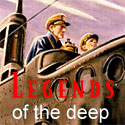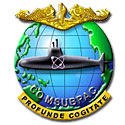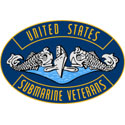You may recall from the book that after a torpedo was accidentally misfired with the muzzle door closed, Wahoo began having difficulty operating her bow buoyancy tank vent valves during dives. Ultimately they failed to operate altogether. Captain Kennedy ordered his engineering officer, Grider, and torpedo specialist, Paine, to open up the manhole on the top of the tank and check out the valve operating mechanism from the inside. They did this while surfaced at night in Japanese waters.
With the ability to slip past the ropes on Batfish, I ventured out to her bow buoyancy tank. It is located over the torpedo tubes in the extreme forward end of the boat and is open to the sea at the bottom through a row of half-round flood holes. On the upper deck are two grated vents which open from the inside to allow air to escape during a dive and to trap the air in the tank when it is blow dry for surfacing. Due to its location the tank helped get the boat heading down and pointing up at the appropriate times.

On deck I found the vents and the manhole cover of the type Grider used to gain access to Wahoo's tank. It was oval shaped, secured with a series of bolts around its perimeter. On Batfish these bolts had been removed and the cover loosely set on top of the studs. The cover itself looked roughly a foot and a half wide and two and a half feet in length. A tight squeeze even for athletic young men in their late twenties and early thirties.

I picked it up and looked inside. The manhole was situated over a ladder mounted to the aft bulkhead of the tank. To port were actuating rods that ran from the bottom of the tank up to the valve mechanisms themselves. The rods went down through the bottom of the tank and were presumably damaged by the misfire in Wahoo's tube 1. There were no baffles in the tank on Batfish only a large space open at the bottom through the flood holes.
Grider describe it as being slick and slimy with an antifoul coating. And dark seawater would have swirled around their feet through the floods. The real threat was being surprised by the Japanese on the surface. In that event they both knew Kennedy would take Wahoo down and they would be on their own.
Making light of the situation, Grider reminded Paine he was senior and entitled to leave the tank first. Paine pointed out that it would never vent, and the boat would fail to dive, with Grider's fat behind stuck in the manhole trying to get out. Now I know how right he was.








0 comments:
Post a Comment